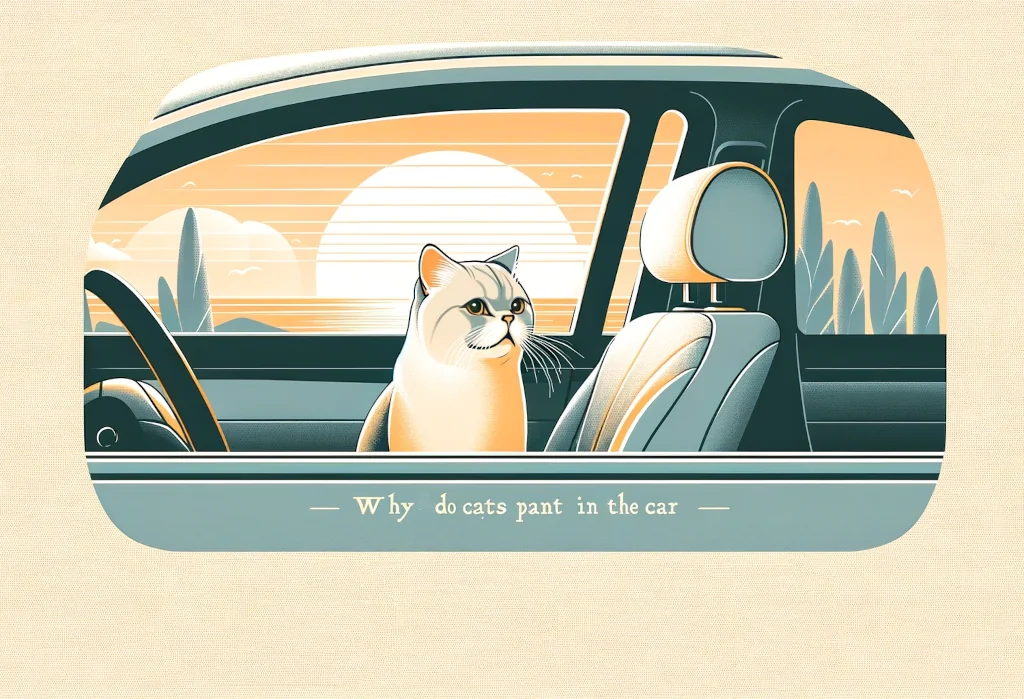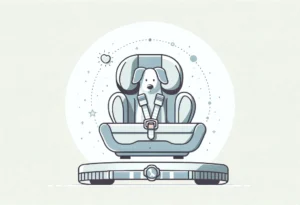There you are, cruising down the highway, your furry copilot next to you, when suddenly the unmistakable sound of panting fills the car. Not from exertion or the thrill of an open window, but panic. It’s a sound that tugs at your heartstrings and turns your glance to the passenger seat with concern.
In this post, we’ll take a journey into the reasons behind this feline behavior and navigate the roads to calmness, offering solutions to ensure your cat’s travel experience is as smooth as the ride itself.

Quick Takeaways:
- Cats pant in cars primarily due to stress, overheating, or motion sickness; understanding this helps in addressing their discomfort.
- Preparing your cat for car rides involves gradual familiarization with the vehicle and carrier, short practice drives, and comforting items or scents from home.
- If panting seems excessive or is accompanied by other distress signs, consult a vet to rule out underlying health issues.
Why Do Cats Pant in the Car?
Ever noticed your furball looking a tad too breathy during car rides? Well, panting in cats, especially in the car, isn’t as common as it is with dogs, and it sure can give a pet parent a bit of a scare. There are a few reasons why your kitty might start panting when they’re riding shotgun (or more safely, tucked in their carrier in the backseat). Let’s unpack them:
-
Stress and Anxiety : Just like us, cats can feel the jitters. New environments or a deviation from their routine (like hopping into a car) can send their stress levels soaring. This anxiety often manifests as panting.
-
Overheating : Cars can get stuffy and hot rather quickly, more so if the air conditioning isn’t reaching the backseat properly. Cats overheat more easily than humans do, leading to panting as they try to cool off.
-
Motion Sickness : Yep, like kids, cats can get car sick too. Nausea and unease from the motion can cause panting, drooling, or even vomiting.
Understanding these triggers is the first step to helping your cat. Now, let’s dig into telling normal panting from the concerning kind.
Is Panting Always a Sign of Distress in Cats?
Panting can be a bit of a gray area. It’s not always a red flag, but it’s not exactly a green light either. Here’s the scoop:
-
Normal Panting : After a pent-up play session, some cats might pant as they catch their breath. This is fairly rare and should resolve quickly as they cool down.
-
Concerning Panting : If your cat is panting in the car (a situation without physical exertion) and showing other signs of distress like drooling, lethargy, or vocalizing, it’s a signal that they’re not okay.
Bottom line, if the panting doesn’t fit the context of recent physical activity, it’s worth paying attention to. Now, onto smoothing those car rides.
How Can You Prepare Your Cat for Car Rides?
Getting your cat to be cool with car travels doesn’t happen overnight, but with the right approach, you can help minimize their stress (and yours too). Here are some steps to turn those car rides from a nightmare to a breeze:
-
Slow and Steady Wins the Race : Start by simply allowing your cat to explore the car while it’s stationary. Let them get comfortable with the environment without the added stress of movement.
-
Safety First : Always use a well-ventilated carrier. It’s safer and helps contain their space, which can be comforting. Pro tip: Spray a pheromone spray like Feliway inside the carrier 15 minutes before travel; it’s a game-changer for reducing anxiety.
-
Short Practice Drives : Gradually introduce your cat to the concept of movement by taking short drives around the block. Gradually extend these as they become more comfortable.
-
Familiarity and Comfort : Bring along their favorite blanket or toy. The familiar scent can be a reassuring presence for your cat.
-
Keep it Cool : Ensure the car is well-ventilated and at a comfortable temperature. Overheating can exacerbate anxiety and discomfort.
One unique tip most miss? Create a positive association: Before and after the ride, engage in an activity your cat loves, be it a treat session or a bit of playtime. This can help them associate car rides with positive experiences.
Incorporating these strategies can significantly improve your cat’s travel experience. Remember, every cat is an individual, and patience is key. Watch for signs of improvement, but understand that some cats may always find car travel challenging. If trips to the vet are a necessity, consider mobile vet services to reduce the need for car rides.
By implementing these insights and tips, not only will your car rides become smoother, but you’ll deepen your understanding of your cat’s needs and behavior. Here’s to happier, safer journeys with your feline friend!
What Can You Do to Reduce Your Cat’s Anxiety During Car Trips?
Traveling by car can be a nerve-racking experience for our feline friends. However, with a bit of preparation and some smart strategies, you can make the journey much more comfortable for them. Here’s how you can help reduce your cat’s anxiety during car trips:
- Introduce Your Cat to the Carrier: Gradually get your cat used to the carrier at home before the trip. Leave it open in a familiar space with a comfy blanket inside. This will help them associate it with safety and comfort.
- Pheromone Sprays: A spritz of feline pheromone spray inside the carrier can work wonders. These sprays mimic the natural pheromones cats produce, helping to soothe and calm them during stressful situations.
- Calming Supplements: Consider offering your cat vet-approved calming supplements or treats before the journey. These can help reduce anxiety without the need for sedatives.
- Bring Comfort from Home: Familiar scents can be incredibly comforting to cats. Tuck their favorite toys or a well-loved blanket into the carrier with them.
- Soft Music or Cat-specific Audio: Playing soft classical music or specially designed cat calming soundtracks can create a calming environment in the car.
- Take Short Practice Runs: Gradually acclimate your cat to car travel by taking short, positive trips that end with a treat or playtime, gradually increasing the duration as they become more comfortable.
One unique tip that is often overlooked is to avoid feeding your cat right before traveling. Some cats are prone to motion sickness, and traveling on an empty stomach can help prevent this. However, always ensure your cat is well-hydrated before, during, and after the trip.
Recognizing When It’s More than Just Car Anxiety
While panting and showing signs of anxiety during car rides can be relatively normal for some cats, it’s crucial to know when these symptoms might indicate something more serious. Here’s how to tell the difference:
- Duration and Intensity: If the panting is excessively heavy, lasts the entire trip, or continues for a significant time after the journey has ended, it might be a cause for concern.
- Accompanied Symptoms: Be on the lookout for other signs of distress or illness, such as drooling excessively, vomiting, lethargy, or unresponsiveness. These could indicate heatstroke, respiratory issues, or other health problems.
- Frequency: If your cat never used to pant in the car but has suddenly started, it’s worth investigating further.
- Physical Exertion: Panting after a stressful but physically inactive car ride is unusual and differs from panting after play or exercise.
When in doubt, it’s always best to consult a veterinarian. They can help rule out any underlying health issues and offer additional strategies for managing travel anxiety in your cat.
Remember, every cat is unique, and what works for one may not work for another. Paying close attention to your cat’s behavior and preferences, and adjusting your approach as necessary, will help make car travel a more positive experience for both of you.
Alex, a passionate animal lover, has experience in training and understanding animal behavior. As a proud pet parent to two dogs and three cats, he founded AnimalReport.net to share insights from animal experts and expand his knowledge of the animal kingdom.




